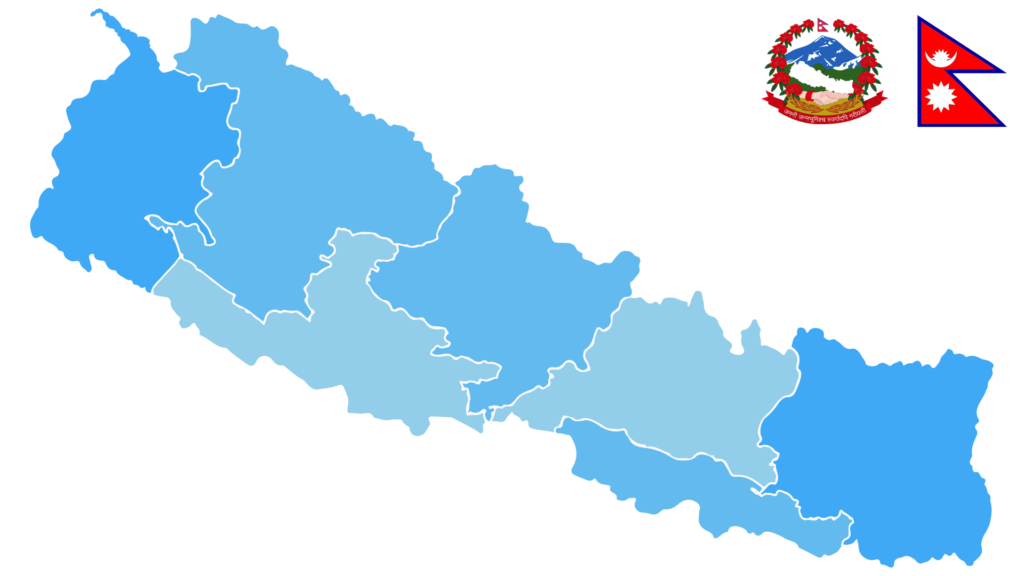About Nepal

GEOGRAPHY
Area: 147181 Sq. Km.
Length: 885 Km (East to West)
Width: on Uniform, Mean Width of 193 km from North to South.
Shape: Roughly Rectangular.
BOUNDARIES
East: West Bengal (India)
West: UP (India)
North: Tibet (China) South: UP (India)
Location
Latitude: 26°22’N–3027’N
Longitude: 80°4E-88°12’E It is a landlocked country, the nearest seaport is Calcutta in India which is 1120 km away from Kathmandu, the capital of the country.
Altitude Range: From 70m above sea level (230ft) in the Terai to 8850 m (29,028ft) at Sagarmatha (Mt. Everest)
Time: 15 minutes ahead of India Standard Time, 5 hours 45 minutes ahead of GMT.
Population: 25.7 million Approx.
Language: Nepali is the national language, Devanagari the script. Altogether 26 languages are spoken.
ABOUT NEPAL
Nepal is a small country sandwiched between two great giant countries China in the North and India in the East, West, and South. This country being landlocked, people sometimes describe it as “the home of the mountains.”
This country was closed to the western world until the 1950s. Only a few people had chances to hear about this small country.
About 25.7 million population resides in this small country. Nepal is the only Hindu monarchial Kingdom in the world and the King is regarded as an incarnation of the Hindu god, Bishnu, one of the 33 million Gods.
People’s movements in 1990 had ushered some freedom to people during this movement. People have had right to exercise a multiparty system and democracy. However, due to lacking the organism in leadership to run the country, the King dissolved the parliaments and resumed all the power to himself again. This happened after 14 years since the time of movement in 1990.
The national language of the state is Nepali. All the works of governmental offices are done in the Nepali language.
In spite of being a small country, the variation of social structure is its main feature, multilingual, multi-race comprised of many tribes and sub-tribes. Among the total population, Christian occupies 0.8% only.
Statistics
Nepal is the second poorest nation of the world. More then 60 percent of the total population are below the level of poverty and suffered from mal nutritional and health problems. 89% of the total population draws drinking water from wells, springs, and streams with no sanitary safeguards. National literacy is estimated at 37%. Subsistence farming is the source of food and shelter for 90% of all Nepalese. Child mortality is the highest in the world at 146 deaths per each 1,000 birth. The average life expectancy is 55 years.
Evangelism in our country
Nepal was considered as only a Hindu country but by the grace of God and due to the prayers of Christians, it has now become a secular nation. Nepal consists of different languages, castes, and beliefs. Hinduism is a major religion in Nepal, So, Hindu wants to keep their pride of being Hindu in the world. Higher Hindus have more privilege in the society and they lose it if people convert to Christianity or any other religion. So they do not want Christians to be increased. Another social reason that hinders the work of evangelism is a caste system, It is the major issue. All people are identified with their respective caste in society and as well as Government. When a person becomes a Christians, He/She lose his/her identity and become without cast so the Christians do not have social participation and as well in government.
Christianity is considered a foreign and cow-eating religion in Nepal. Even though the country has become democratic, Christians do not have the privilege to work in government office unless they hide their religion. The government of Nepal has opened doors for missions to come in and to help in health, education, and development but there are not many changes in the constitution regarding religion.
Nepal itself is coming under the category of poor in the world. The country has to depend on agriculture because 85% is involved in agriculture. Christians are not getting any help from the country socially, economically, and politically.
How Christianity came to my country
During the 18th century, few catholic monks from Rome came to Nepal and met with the then ruling Malla kings and with their permission started evangelizing the people in the Kathmandu Valley. In 1767, in his mission of making a single Nepal, king Prithivi Narayan Shah invaded Kathmandu Valley and he pressured the foreign catholic fathers and the converted Nepalese to leave the country suspecting that they could be in league with the then British rulers in India. From that point of time until a brief revolution leading to the establishment of democratic rule in Nepal in 1950, the door to Christianity had been totally closed. Through the prayers of Nepalese living outside Nepal, the good news of the Lord could come to the country again after 1950. This is also because the Rana rulers had closed everything in Nepal to outside influence for 104 years of their own despotic rule and therefore the new government had no option but to open the doors for international assistance in the various fields of health, education, and rural development efforts. A real effort in evangelism started only after this time and the Christians grew both in numbers and understanding of the Word of the Lord. Missionaries came to work as social workers. They had testified and witnessed through their lives and words. Some of them came from Darjeeling. That time it was very difficult for them to live; they couldn’t say they are Christians but witnessed through their lifestyle. So it was very difficult in the initial phase of Christianity in Nepal.
We, Christians are reaching to the people in a different part of Nepal in different ways and we are communicating them by different methods though we have many challenges and needs in the society and as well as in the whole country. To make the message of Christ relevant and meaningful, we have to preach and be a witness to the everlasting Gospel of Jesus Christ and establish his kingdom in the nation of Nepal. We are empowering local and national church leaders to plant churches among remote people. We are constructing buildings for churches, Bible schools, and Children’s homes. Gospel messages can be made especially understandable by different means of communication like TV programs and radio programs, gospel tracts. Many tribal groups that get not reached with the gospel and the Bible are not translated in their language. We are facing hardship in theological fields, so churches have to develop training centers and train many pastors.
